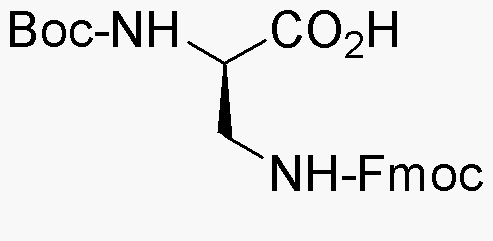Na-Boc-Nb-Fmoc-D-2,3-diaminopropionic acid is widely utilized in research focused on:
- Peptide Synthesis: This compound serves as a valuable building block in the synthesis of peptides, particularly in the development of therapeutic agents. Its protective groups facilitate selective reactions, enhancing efficiency in creating complex peptide structures.
- Drug Development: In pharmaceutical research, it plays a crucial role in designing and optimizing drug candidates, especially those targeting specific biological pathways. Its unique structure allows for the modification of drug properties, improving efficacy and reducing side effects.
- Bioconjugation: The compound is used in bioconjugation processes, where it helps attach biomolecules to drugs or imaging agents. This application is vital in creating targeted therapies and diagnostic tools, enhancing the precision of treatments.
- Research in Neuroscience: It is utilized in studies related to neuropeptides, contributing to the understanding of neurological functions and disorders. Its application in this field aids in the development of potential treatments for conditions like depression and anxiety.
- Material Science: The compound finds use in creating novel materials with specific properties, such as hydrogels for drug delivery systems. This application is particularly beneficial in developing smart materials that respond to environmental stimuli.
General Information
Properties
Safety and Regulations
Applications
Na-Boc-Nb-Fmoc-D-2,3-diaminopropionic acid is widely utilized in research focused on:
- Peptide Synthesis: This compound serves as a valuable building block in the synthesis of peptides, particularly in the development of therapeutic agents. Its protective groups facilitate selective reactions, enhancing efficiency in creating complex peptide structures.
- Drug Development: In pharmaceutical research, it plays a crucial role in designing and optimizing drug candidates, especially those targeting specific biological pathways. Its unique structure allows for the modification of drug properties, improving efficacy and reducing side effects.
- Bioconjugation: The compound is used in bioconjugation processes, where it helps attach biomolecules to drugs or imaging agents. This application is vital in creating targeted therapies and diagnostic tools, enhancing the precision of treatments.
- Research in Neuroscience: It is utilized in studies related to neuropeptides, contributing to the understanding of neurological functions and disorders. Its application in this field aids in the development of potential treatments for conditions like depression and anxiety.
- Material Science: The compound finds use in creating novel materials with specific properties, such as hydrogels for drug delivery systems. This application is particularly beneficial in developing smart materials that respond to environmental stimuli.
Documents
Safety Data Sheets (SDS)
The SDS provides comprehensive safety information on handling, storage, and disposal of the product.
Product Specification (PS)
The PS provides a comprehensive breakdown of the product’s properties, including chemical composition, physical state, purity, and storage requirements. It also details acceptable quality ranges and the product's intended applications.
Certificates of Analysis (COA)
Search for Certificates of Analysis (COA) by entering the products Lot Number. Lot and Batch Numbers can be found on a product’s label following the words ‘Lot’ or ‘Batch’.
*Catalog Number
*Lot Number
Certificates Of Origin (COO)
This COO confirms the country where the product was manufactured, and also details the materials and components used in it and whether it is derived from natural, synthetic, or other specific sources. This certificate may be required for customs, trade, and regulatory compliance.
*Catalog Number
*Lot Number
Safety Data Sheets (SDS)
The SDS provides comprehensive safety information on handling, storage, and disposal of the product.
DownloadProduct Specification (PS)
The PS provides a comprehensive breakdown of the product’s properties, including chemical composition, physical state, purity, and storage requirements. It also details acceptable quality ranges and the product's intended applications.
DownloadCertificates of Analysis (COA)
Search for Certificates of Analysis (COA) by entering the products Lot Number. Lot and Batch Numbers can be found on a product’s label following the words ‘Lot’ or ‘Batch’.
*Catalog Number
*Lot Number
Certificates Of Origin (COO)
This COO confirms the country where the product was manufactured, and also details the materials and components used in it and whether it is derived from natural, synthetic, or other specific sources. This certificate may be required for customs, trade, and regulatory compliance.


